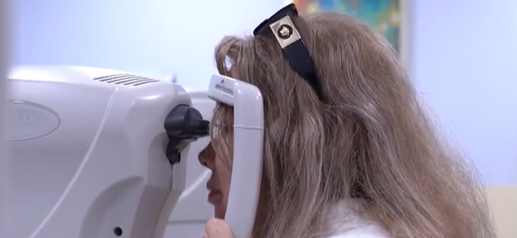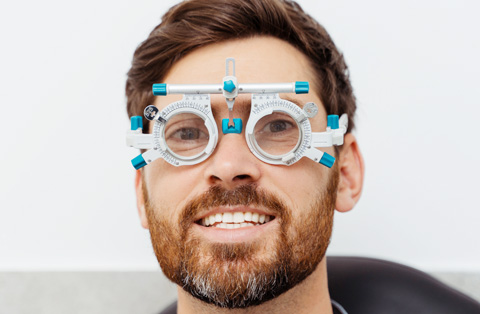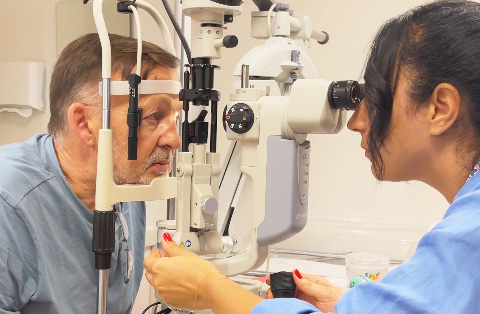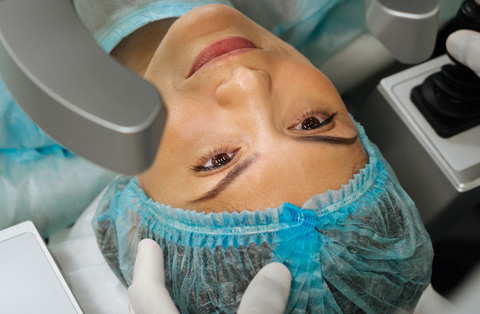Struggling with blurred or distorted vision from astigmatism? Laser eye surgery offers a safe, lasting solution to restore sharp, clear sight, without the need for glasses or contact lenses.
What is Astigmatism?
Astigmatism is a common refractive error. It happens when the shape of your cornea or lens is not perfectly round. Instead of being shaped like a basketball, it’s shaped more like a football. This uneven shape prevents light from focusing properly on the retina, which is the light-sensitive surface at the back of your eye.
As a result, vision becomes blurred or distorted at all distances. You may struggle to see clearly up close or far away. You might also experience eye strain, headaches, or trouble seeing at night.
Astigmatism often occurs with nearsightedness (myopia) or farsightedness (hyperopia). It can be present from birth or develop later in life. It’s not a disease. It’s just a different shape of the eye. Glasses, contact lenses, or laser eye surgery can correct it.
What Causes Astigmatism?
Astigmatism is usually caused by an irregular shape of the cornea or the lens inside the eye. In a healthy eye, the cornea and lens have a smooth, even curve. This allows light to bend properly and focus on one sharp point on the retina.
In astigmatism, the surface is more oval than round. This uneven curve causes light to focus on multiple points, either in front of or behind the retina. That leads to blurry or distorted vision.
There are a few main reasons why astigmatism can happen:
Genetics: It often runs in families and may be present at birth.
Eye injuries or surgery: Trauma to the eye or some surgical procedures can change the shape of the cornea.
Keratoconus: This is a rare condition where the cornea becomes thinner and cone-shaped over time.
Eyelid pressure: Constant pressure on the cornea from drooping eyelids may also contribute.
Astigmatism is not caused by reading in low light or sitting too close to screens. It’s a structural issue, not something you can develop from daily habits.
How Common is Astigmatism?
Astigmatism is very common. It affects people of all ages, from children to older adults. Most people have some degree of it, even if it’s so mild that they don’t notice any symptoms.
According to studies, about one in three people has clinically significant astigmatism. It often appears together with other refractive errors like myopia (nearsightedness) or hyperopia (farsightedness). It can also change over time, especially during childhood or after certain eye surgeries.
Many people learn they have astigmatism during a routine eye exam. It can affect one or both eyes. And because it’s so common, correcting it with glasses, contact lenses, or laser surgery is a standard part of modern eye care.
How Does Laser Eye Surgery Correct Astigmatism?
Laser eye surgery corrects astigmatism by reshaping the cornea. This helps light focus properly on the retina, improving vision. The procedure is precise and uses advanced laser technology to smooth out the irregular curvature that causes blurry or distorted sight.
Here’s how it works:
Diagnosis: First, the surgeon maps the cornea in detail using special imaging. This creates a custom treatment plan.
Laser reshaping: A laser then removes tiny amounts of tissue from the cornea. It flattens the steeper areas or steepens the flatter ones, depending on the type of astigmatism.
Refocusing light: This new shape allows light rays to focus on one clear point on the retina.
Types of Laser Eye Surgeries used for Astigmatism
There are a few types of laser eye surgeries used for astigmatism:
LASIK (Laser-Assisted In Situ Keratomileusis): The surgeon creates a thin flap in the cornea, lifts it, then uses a laser to reshape the underlying tissue.
PRK (Photorefractive Keratectomy): No flap is created. The laser reshapes the surface of the cornea directly after removing the top layer.
SMILE (Small Incision Lenticule Extraction): A newer method where a small piece of tissue is removed from inside the cornea through a tiny incision.
Each technique has its advantages. Your eye structure, degree of astigmatism, and lifestyle all help determine which method is best for you.
The Science Behind Cornea or Lens Reshaping
To understand how laser eye surgery works, we need to look at the role of the cornea and lens. Both parts bend (or refract) light to focus it on the retina. When they have a perfect shape, the light comes to a single, sharp point. That’s how you see clearly.
In astigmatism, the cornea or lens has an uneven curve. Light rays scatter instead of focusing. The result is blurred or distorted vision.
Laser surgery corrects this by reshaping the cornea. Here’s the science behind it:
Refraction and focus: Light enters the eye and bends through the cornea and lens. The cornea does most of the bending. If the cornea is too curved in one direction, it needs to be flattened. If it’s too flat, it needs to be steepened. The goal is to make the curvature even in all directions.
Laser precision: Excimer lasers use ultraviolet light to remove tissue at a microscopic level. These lasers are accurate down to fractions of a micron. That means surgeons can adjust the curve of the cornea without damaging surrounding tissue.
Customized reshaping: The laser reshaping is based on a topographic map of the eye. This map shows exactly where and how the curve is uneven. The laser then reshapes only those areas, so the surface becomes more regular.
When the cornea has a smooth, symmetrical curve, light can focus properly. That’s how vision becomes clearer after surgery.
Am I a Suitable Candidate for Laser Eye Surgery to Correct Astigmatism?
Not everyone with astigmatism is a good candidate for laser eye surgery. Certain conditions must be met to ensure the procedure is safe and effective.
Here are the key factors that determine suitability:
Age: You should be at least 18 years old. Your vision must be stable for at least one year.
Eye health: Your eyes should be free from infections, injuries, or diseases such as severe dry eye or keratoconus.
Corneal thickness: Your cornea must be thick enough to allow safe reshaping. Thin corneas may not support LASIK but could be eligible for PRK or SMILE.
Degree of astigmatism: Mild to moderate astigmatism is usually treatable. Very high levels may need special evaluation.
Stable vision: Your prescription should not have changed significantly in the past year.
General health: Certain conditions like autoimmune diseases or uncontrolled diabetes may affect healing and increase risks.
Pregnant or breastfeeding women are advised to wait, as hormone changes can affect vision.
An eye surgeon will perform detailed tests to check your cornea, vision stability, and overall eye health. These evaluations are critical to ensure the best results.
Types of Astigmatism That Can Be Corrected
Laser eye surgery can correct most common types of astigmatism by reshaping the cornea. Each type affects how light enters the eye and where it focuses. The main goal is to create a smooth, even curve so light focuses on one clear point on the retina.
Here are the main types of astigmatism that surgery can correct:
Corneal Astigmatism: This is the most common type. It happens when the cornea (the front surface of the eye) has an irregular shape. Laser surgery targets and reshapes this outer layer.
Lenticular Astigmatism: This is caused by an irregular shape of the lens inside the eye. While laser surgery doesn’t change the lens, in many cases, reshaping the cornea can still help improve focus and reduce distortion.
Astigmatism can also be classified by how it distorts vision:
With-the-Rule Astigmatism: The vertical curve is steeper than the horizontal. This is common in younger people and usually responds well to laser treatment.
Against-the-Rule Astigmatism: The horizontal curve is steeper. It’s more common in older adults and also treatable with modern laser techniques.
Oblique Astigmatism: The steepest curves are at an angle, not purely vertical or horizontal. This type is more complex but still manageable with customized laser corrections.
In most cases, laser surgery offers effective and lasting correction. A detailed eye exam will determine which type you have and how well it can be treated.
When Laser Vision Correction May Not Be Recommended
Laser vision correction is generally safe and effective, but it’s not suitable for everyone. There are certain conditions and risk factors that may make the procedure unsafe or less effective.
Here are situations where laser surgery may not be recommended:
Unstable vision: If your prescription is still changing, especially in the last 12 months, surgery should be delayed.
Very high refractive errors: Severe astigmatism or other vision problems may be outside the safe correction range for lasers.
Thin or irregular corneas: If your cornea is too thin or shows signs of disease (like keratoconus), reshaping it could weaken the eye.
Eye diseases: Conditions such as glaucoma, cataracts, chronic dry eyes, or infections can affect healing and outcomes.
Autoimmune or immune-compromised conditions: Diseases like lupus or rheumatoid arthritis may delay healing and increase the risk of complications.
Pregnancy or breastfeeding: Hormonal changes can affect vision stability, so it’s best to wait until after this period.
Certain medications: Some drugs, like steroids or acne treatments, can affect healing or eye health.
In these cases, your surgeon may suggest alternative treatments. These might include special contact lenses, implantable lenses, or other refractive procedures. The goal is always to protect your eye health while improving your vision safely.
What Results Can I Expect After Astigmatism Laser Correction?
Laser correction for astigmatism offers very good results for most patients. Many people experience clear, sharp vision without glasses or contact lenses soon after the procedure.
Here’s what you can typically expect:
Improved vision: Most patients achieve 20/25 vision or better. This means you can perform most daily tasks without glasses. If you also had myopia or hyperopia, those issues are often corrected at the same time.
Quick recovery: Vision often improves within a day or two. It may take a few weeks for it to fully stabilize, especially in PRK procedures.
Long-lasting results: In most cases, the correction is permanent. Your eye shape stays stable, and the need for retreatment is low.
High satisfaction: Studies show that over 95% of patients are satisfied with their vision after surgery.
However, results can vary based on factors like your eye health, degree of astigmatism, and age. You may still need low-strength glasses for tasks like reading or driving at night, especially if you're over 40 and developing presbyopia.
Regular follow-ups help monitor healing and ensure your eyes stay healthy.
What Are the Potential Complications of Laser Eye Surgery for Astigmatism?
Laser eye surgery for astigmatism is generally safe. It’s a well-established procedure with a high success rate. However, like any surgery, it carries some risks. Most side effects are mild and temporary. Serious complications are rare, especially when performed by experienced surgeons.
Possible side effects and complications include:
Dry eyes: This is the most common issue. It usually improves within a few months.
Glare or halos: You may see halos around lights, especially at night. This tends to fade as the eye heals.
Under-correction or over-correction: In some cases, the initial result may not be perfect. A second procedure, called an enhancement, can help fine-tune the vision.
Infection or inflammation: These are rare but can occur. Antibiotic and anti-inflammatory drops help prevent this.
Flap issues (in LASIK): If the corneal flap isn’t made properly, it may cause problems. Surgeons use advanced lasers to reduce this risk.
Ectasia: A rare condition where the cornea becomes too thin and starts to bulge. This is why proper screening is so important.
Most people recover without issues. Choosing a qualified surgeon and following post-op instructions helps minimize risks. If you’re not a good candidate, your doctor will recommend safer alternatives.
How Much Does Laser Eye Surgery for Astigmatism Cost?
The cost of laser eye surgery for astigmatism can vary widely depending on where you have the procedure. Prices depend on the technology used, the surgeon’s experience, and what is included in the treatment package.
Average costs by region:
United States: Prices range from $2,000 to $3,500 per eye. Some clinics charge more for custom LASIK or advanced laser technologies.
United Kingdom: Expect to pay between £1,500 and £2,500 per eye, depending on the clinic and the procedure type.
Western Europe: Countries like Germany, France, and the Netherlands offer laser eye surgery at around €1,800 to €3,000 per eye.
Türkiye offers the same procedures at much more affordable prices—often 50–70% less than in the US or UK. Despite the lower costs, Türkiye is known for world-class quality, internationally accredited hospitals, and highly experienced surgeons. Many of these surgeons trained or practiced in Europe or North America.
The technology used in Turkish clinics is often the same as in top centers around the world. Packages often include accommodation, airport transfers, and patient coordination, making Türkiye a preferred choice for international patients. It provides both medical excellence and financial comfort.
What Is the Recovery Process After Astigmatism Laser Correction?
Recovery after laser eye surgery for astigmatism is usually quick and smooth. Most patients notice clearer vision within the first 24 to 48 hours. Full recovery, however, can take a few weeks depending on the type of procedure.
Here is what to expect during the healing process:
First 24 hours: You may feel mild discomfort, like dryness, itching, or a gritty sensation. Vision may be blurry or hazy. Resting your eyes and avoiding screens helps.
First week: Vision begins to stabilize. Most people return to work within a few days. Eye drops are used to prevent infection and reduce inflammation. Avoid rubbing your eyes or getting water in them.
First month: Your vision continues to improve. You’ll attend follow-up visits to monitor healing. Avoid strenuous activities and dusty environments during this period.
After one month: Most people have stable vision. Night glare or halos may still be present but usually fade over time. Dryness may persist for a few months, especially after LASIK.
PRK recovery is slower than LASIK or SMILE, as it involves healing the surface layer of the cornea. Your surgeon will guide you through specific care steps based on your procedure.
Following all aftercare instructions and attending check-ups ensures the best results and protects your eye health.





